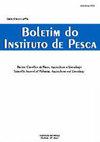刺网对在马德拉河(巴西朗多尼亚)洪泛区捕获的主要鱼类的选择性
IF 0.6
4区 农林科学
Q4 FISHERIES
引用次数: 0
摘要
亚马逊河流域洪泛平原的小规模捕鱼活动日益频繁,刺网是主要的捕鱼工具之一。在这项研究中,我们评估了马德拉河流域洪泛平原湖泊中鱼类物种的长度结构,强调了渔网对主要捕捞物种的选择性。我们在丰水期和枯水期使用网目尺寸为 40、60、80、100、120 和 160 毫米的渔网进行捕捞。使用 SELECT 计算代码进行了不同时期的测试和网目比较,并估算了选择性曲线的参数。文中记录了 17 种新的最大长度。在 12 个最丰富的物种中,网目尺寸为 40、60、80 和 100 毫米的渔网对苏里南鳀鱼模态长度的选择性分别为 13.3、19.9、26.6 和 33.2 厘米。在三种最小网目尺寸中,Potamorhina altamazonica 的数值分别为 12.7、19.0 和 25.3 厘米,Pellona flavipinnis 的数值分别为 15.4、23.2 和 30.9 厘米。在两个最小网目尺寸中,Potamorhina latior(12.9 和 19.4 厘米)、Potamorhina rutiloides(11.3 和 16.9 厘米)、Triportheus elongatus(19.7 和 29.5 厘米)、Triportheus flavus(14.1 和 21.1 厘米)和 Pimelodus blochii(15.5 和 23.0 厘米)的数值如下。对渔网选择性的估计不仅是渔业科学的基本信息,也是亚马逊鱼类种群管理的基础。本文章由计算机程序翻译,如有差异,请以英文原文为准。
Selectivity of gillnets on the main fish species caught in the floodplains of the Madeira River (Rondônia, Brazil)
Small-scale fishing in the floodplains of the Amazon basin has intensified, with gillnets being one of the main types of tackle used. In this study, we evaluated the length structure of fish species in a floodplain lake of the Madeira River basin, emphasizing the selectivity of the nets in the main species caught. The fisheries were collected in periods of high water and low water, with nets of mesh sizes of 40, 60, 80, 100, 120 and 160 mm. Tests between the periods and also comparing the meshes were performed and the parameters of the selectivity curves estimated with the SELECT calculation code. Records of 17 new maximum lengths are presented. Of the 12 most abundant species, the selectivity of the nets in the modal lengths for Anchovia surinamensis were 13.3, 19.9, 26.6 and 33.2 cm in the nets with mesh sizes of 40, 60, 80 and 100 mm, respectively. In the three smallest mesh sizes, the values for Potamorhina altamazonica were 12.7, 19.0 and 25.3 cm and for Pellona flavipinnis values were 15.4, 23.2 and 30.9 cm. In the two smallest mesh sizes, the following values were presented for the species Potamorhina latior (12.9 and 19.4 cm), Potamorhina rutiloides (11.3 and 16.9 cm), Triportheus elongatus (19.7 and 29.5 cm), Triportheus flavus (14.1 and 21.1 cm) and Pimelodus blochii (15.5 and 23.0 cm). The estimates of selectivity of the nets, in addition to being basic information for fishery sciences, are also fundamental for the management of Amazonian fish stocks.
求助全文
通过发布文献求助,成功后即可免费获取论文全文。
去求助
来源期刊

Boletim do Instituto de Pesca
FISHERIES-ZOOLOGY
CiteScore
0.80
自引率
0.00%
发文量
24
审稿时长
>12 weeks
期刊介绍:
To publish original articles of research and short communications in the following áreas: Fisheries, Aquaculture, Zootechnology, Limnology, Oceanography, Biology and Pathology of aquatic organisms. The publication depends on the approval of the Editorial Board, based on the peer review.
 求助内容:
求助内容: 应助结果提醒方式:
应助结果提醒方式:


